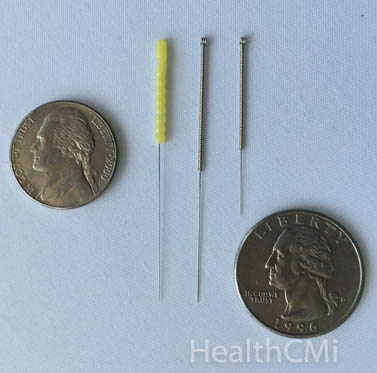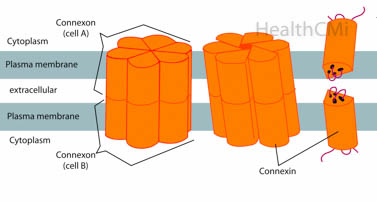Acupuncture point LU11 (Shaoshang) has a confirmed anatomical composition. Researchers using fluorescence microscopy determined that the epidermal and underlying dermis layers of acupoint LU11 contain high densities of connexins, important intercellular communication structures.  The researchers note that their findings support the principle that acupuncture points are “structurally defined entities.”
The researchers note that their findings support the principle that acupuncture points are “structurally defined entities.”
Connexons are comprised of connexins and are proteins that form gap junctions. A gap junction allows ions and molecules to pass between cells. When two adjacent cells align, a connexon in the membrane of one cell lines up with a connexon in the membrane of another cell. This creates an aqueous pathway for ions and molecules to transfer between the cells.
Connexins are the building blocks of gap junctions. There are six connexins that form a connexon and two connexons that form a gap junction. The researchers note that if the connexins found in LU11 form gap junctions or hemi-channels, they potentially contribute to rapid changes in electrical resistance in local tissues.
The researchers discovered an increase of connexin 26 and connexin 43 densities compared with controls. The increased densities extended to the stratum spinosum, stratum basale, subcutis, sweat glands, blood vessels, and fibrocytes. This research provides insight into the physical structure of acupuncture point LU11.
LU11 is located on the lateral aspect of the thumb at the junction of the lines intersecting from the radial border of the fingernail and the base of the fingernail. This acupoint is indicated for the treatment of loss of consciousness, sore throat, tonsillitis, and apoplectic delirium. According to Traditional Chinese Medicine (TCM) principles, LU11 functions to cool the lungs, benefit the pharynx, and revive patients after fainting.
In a related study, CT scans revealed anatomical structures related to acupuncture points ST36 (Zusanli) and ST37 (Shangjuxu). The researchers note that unique microvascular densities with bifurcations “can be clearly seen around thick blood vessels” at the acupoints. The acupuncture points showed both fine and thick high density blood vessel structures. Non-acupuncture points did not exhibit these characteristics.
Another research team took amperometric oxygen microsensor readings and discovered that acupuncture points P7 and P6 demonstrate high oxygen pressure levels. Surrounding areas do not exhibit these characteristics. This fascinating research documents that the lung, pericardium, and heart channel acupoints of the distal forearm and wrist crease region have high oxygen pressure levels. Non-acupuncture point areas throughout this entire region do not exhibit this quality.

Other research measured anatomical structures associated with acupuncture points. Wang et al. note that there is a “vessel-like structure” composed of “calcitonin gene related peptide (CGRP)-positive neurofibers in local tissues” located at acupoints. They add, “CGRP-positive nerve fibers were found to distribute in the dermis and subcutaneous layers of local tissues of acupoint ST 44, ST 36 and ST 32, mainly concentrating around the vessel-like structure.” The researchers conclude that “CGRP-positive neurofibers are an important element in the local tissues of acupoint ST 44, ST 36 and ST 32 regions….”
Connexins, microvascular bifurcated densities, oxygen pressure levels, and CGRP-positive neurofibers are a few of the unique characteristics and structures at acupuncture points documented by recent research. This compliments ancient Chinese medicine acupuncture channel theory with verifiable scientific data. Next, we look forward to continued research and a meta-analysis of the findings to confirm the results and their relationship to clinical efficacy.
References:
Does the Acupuncture Pont Shaoshang (Lu11) in Humans Match with an Increased Density of Connexines? Pilz-Klement, Ines, and Christian-Albrecht May. "Cytology & Histology." (2014).
Chenglin, Liu, Wang Xiaohu, Xu Hua, Liu Fang, Dang Ruishan, Zhang Dongming, Zhang Xinyi, Xie Honglan, and Xiao Tiqiao. "X-ray phase-contrast CT imaging of the acupoints based on synchrotron radiation." Journal of Electron Spectroscopy and Related Phenomena (2013).
Minyoung Hong, Sarah S. Park, Yejin Ha, et al. “Heterogeneity of Skin Surface Oxygen Level of Wrist in Relation to Acupuncture Point,” Evidence-Based Complementary and Alternative Medicine, vol. 2012, Article ID 106762, 7 pages, 2012.
Wang, C., W. J. Xie, M. Liu, J. Yan, J. L. Zhang, Z. Liu, and L. N. Guo. "[Distribution of calcitonin gene related peptide positive neurofibers in local skin tissues of" Neiting"(ST 44)," Zusanli"(ST 36) and" Futu"(ST 32) regions in the rat]." Zhen ci yan jiu= Acupuncture research/[Zhongguo yi xue ke xue yuan Yi xue qing bao yan jiu suo bian ji] 39, no. 5 (2014): 377-381.


